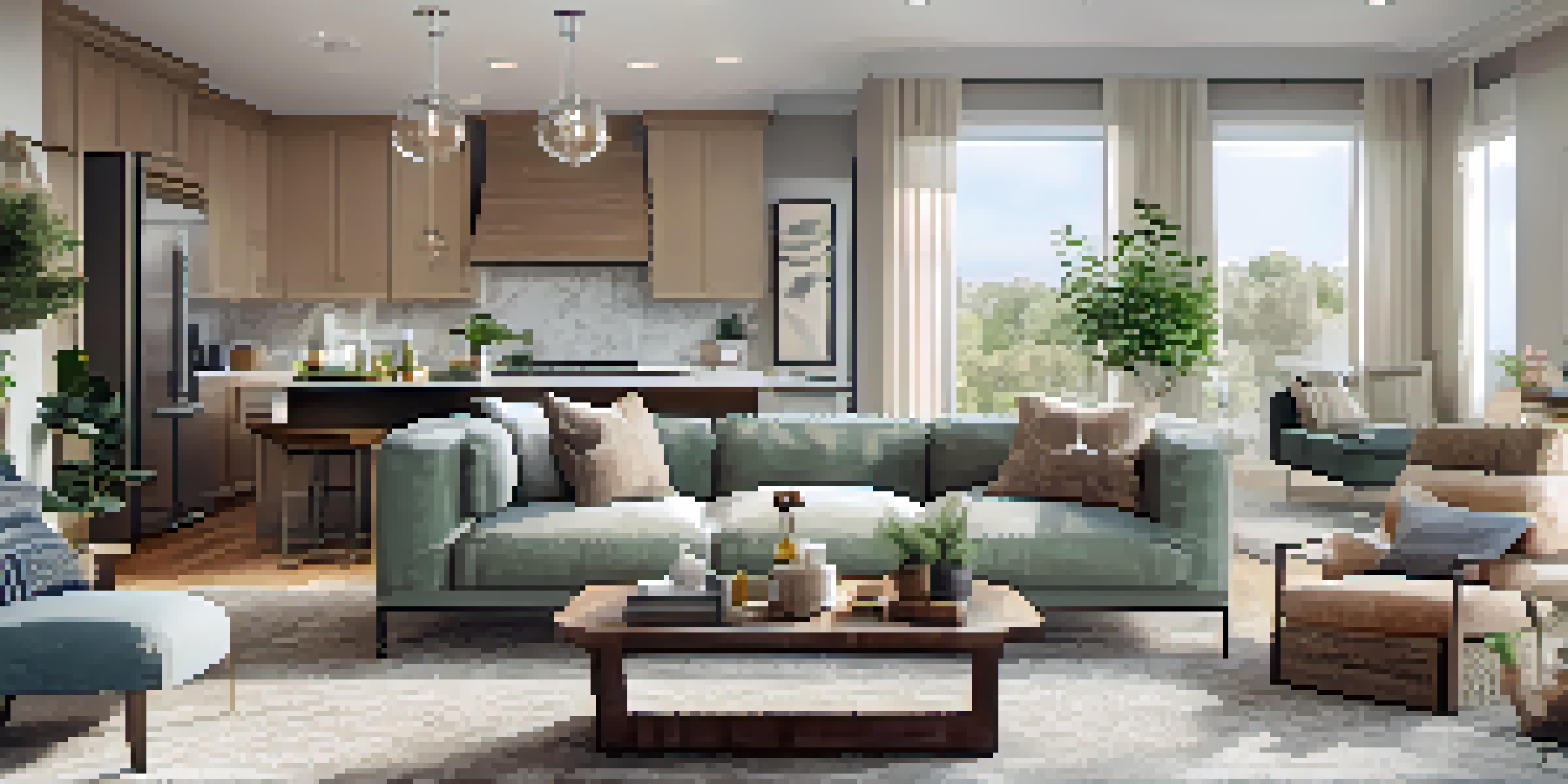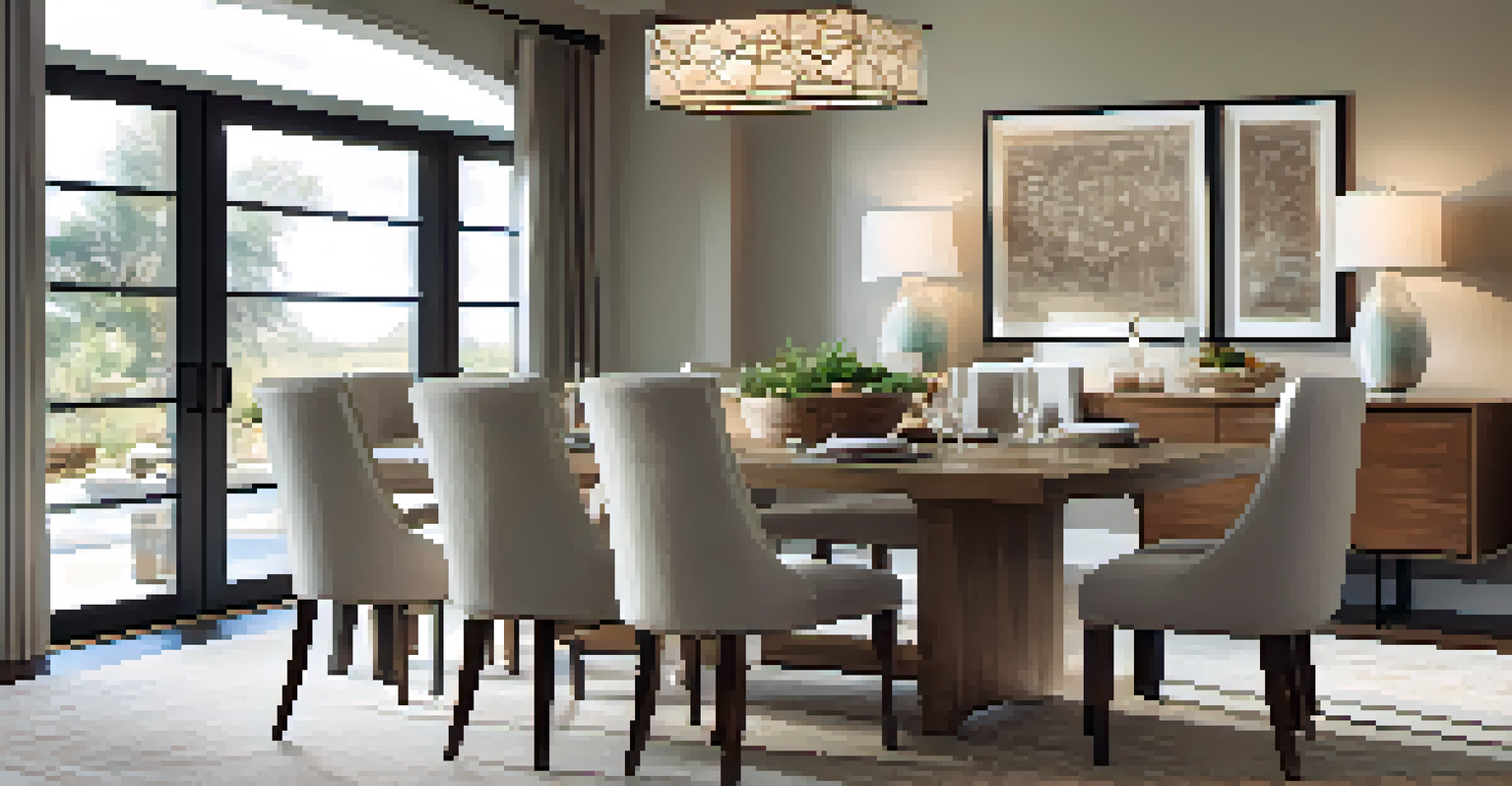Creating a Seamless Flow in Open Concept Living

Understanding Open Concept Living Spaces
Open concept living spaces have become increasingly popular, blending areas like the kitchen, dining, and living room into one cohesive environment. This layout promotes social interaction and a sense of togetherness, making it ideal for families and entertaining guests. However, achieving a seamless flow in these spaces requires thoughtful design and arrangement.
The best rooms have something to say about the people who live in them.
To fully embrace the benefits of open concept living, it’s essential to understand how different areas interact. Each zone should serve its purpose while still feeling connected to the others. This connection creates a harmonious environment, allowing for easy movement and visual continuity, which can enhance your overall living experience.
With an open concept layout, consider how you use your space daily. Reflecting on your lifestyle can help you make informed decisions about furniture placement, color schemes, and decor, ultimately enhancing the flow between different areas.
Establishing Clear Zones with Furniture
One of the best ways to create a seamless flow in an open concept space is by using furniture to define distinct areas. For instance, a strategically placed sofa can separate the living area from the dining space while maintaining an open feel. Adding rugs can also help delineate zones without closing off the space.

Think about your furniture choices and arrangements as tools for guiding movement. For example, an L-shaped sectional can invite conversation while still allowing pathways for foot traffic. Opt for multi-functional pieces, like ottomans or coffee tables with storage, to maximize the utility of your space.
Define Zones with Strategic Furniture
Using furniture placement effectively can create distinct areas within open concept spaces while maintaining an inviting and cohesive flow.
In addition to functionality, consider the visual aspect of your furniture layout. A well-placed bookshelf or console table can serve as a subtle divider that enhances the flow and adds style to your open concept area.
Color Schemes that Enhance Flow
Color plays a significant role in creating a cohesive look in open concept living spaces. Choosing a consistent color palette throughout the areas can help tie everything together visually. Soft, neutral tones can make the space feel larger and more inviting, while pops of color can add personality and energy.
Design is not just what it looks like and feels like. Design is how it works.
Consider employing the 60-30-10 rule when selecting colors: 60% should be a dominant color, 30% a secondary color, and 10% an accent color. This balance ensures that no single area overwhelms the others, fostering a sense of unity across the space.
Additionally, using the same or similar hues in different areas can create a continuous flow. For example, if you have a bold feature wall in the living room, choose a softer version of that color for the dining area to maintain harmony without being too matchy-matchy.
Lighting to Create Atmosphere and Flow
Lighting is another crucial element in establishing a seamless flow in open concept spaces. A mix of ambient, task, and accent lighting can enhance the overall atmosphere while guiding the eye through different areas. Pendant lights over the dining table can define that space, while floor lamps in the living area can create a cozy atmosphere.
Don’t forget about natural light! Large windows or sliding doors can connect your indoor and outdoor spaces, making everything feel more integrated. Mirrors can also help reflect light and make the space feel brighter and more open.
Color Schemes for Visual Cohesion
A consistent color palette across different areas enhances visual unity, making the space feel larger and more inviting.
By layering your lighting options, you create flexibility for different moods and activities. A well-lit space can feel inviting and spacious, encouraging movement and interaction.
Incorporating Textures for Interest and Flow
Texture adds depth and interest to open concept living spaces, making them feel more inviting and dynamic. Mixing materials such as wood, metal, and fabric can create a rich environment that captures attention without feeling cluttered. For example, combining a soft area rug with sleek furniture can balance comfort and sophistication.
Consider using textured elements to visually separate areas. A plush throw on a couch can soften the look of a living room, while woven baskets can bring warmth to a dining area. These small details can enhance the flow while also adding personality to your space.
When incorporating texture, aim for a harmonious balance. Too many contrasting textures can overwhelm the senses, while a thoughtful mix can create a cohesive and inviting atmosphere.
Utilizing Open Space for Movement and Accessibility
In open concept living, space management is key to maintaining flow. Ensure there’s enough room for movement between different areas, allowing guests to navigate freely without feeling cramped. Consider leaving pathways of at least three feet wide, particularly in high-traffic areas like between the kitchen and dining space.
Keep furniture arrangements functional yet stylish. Avoid blocking pathways with large pieces and instead opt for smaller, easily movable items that can adapt to different occasions. This flexibility can enhance the overall flow and accessibility of your space.
Lighting for Atmosphere and Flow
Layering different types of lighting can enhance the atmosphere of open concept spaces, guiding the eye and encouraging movement.
Additionally, think about the layout in relation to the activities you enjoy. Position furniture in a way that encourages conversation and interaction, creating an inviting atmosphere that promotes a sense of community.
Personal Touches for a Cohesive Space
Adding personal touches is essential to making your open concept living space feel like home. Incorporate artwork, photographs, or cherished items that reflect your personality and style. These elements not only enhance the aesthetic but also create a narrative throughout your space.
When selecting decor, aim for cohesion by choosing pieces that complement your overall theme and color palette. This doesn’t mean everything has to match perfectly, but a consistent style can enhance the flow of your open concept area.

Remember, it’s the little details that make a big difference. Incorporating personal elements can transform a standard open space into a unique reflection of who you are, making it a warm and welcoming environment.